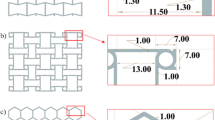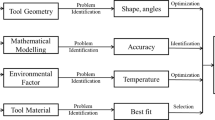Abstract
This paper presents a novel method, based on the particle impact damping (PID), for the attenuation of regenerative vibration in boring operation. A specially designed boring bar having a cavity near machining-end for partial filling of spherical particles has been developed. Characteristics of boring bar with and without PID have been found from impact and shaker tests. After identifying appropriate particle size and filling volume, experiments are conducted to evaluate the performance in actual boring operations. Additional boring experiments are also conducted to confirm the performance by changing particle size and filling volumes. The collision of the particles in PID is found to attenuate regenerative vibration by the energy dissipation and thus effectively enhances stability of the boring operation. Analysis of effect of PID on surface topography in terms of chatter marks, surface roughness, and roundness of bored holes shows that the proposed method results in improvement of bore quality when compared with a boring bar without PID. It is also established that radial vibration of the boring bar has a significant influence on the surface topography obtained in boring operation.
Similar content being viewed by others
References
Åkesson H, Smirnova T, Håkansson L (2009) Analysis of dynamic properties of boring bars concerning different clamping conditions. Mech Syst Signal Process 23(8):2629–2647
Altintas Y, Weck M (2004) Chatter stability of metal cutting and grinding. CIRP Ann Manuf Technol 53(2):619–642
Bai X-M, Keer LM, Wang QJ, Snurr RQ (2009) Investigation of particle damping mechanism via particle dynamics simulations. Granul Matter 11(6):417–429
Bayly PV, Halley JE, Mann BP, Davies MA (2003) Stability of interrupted cutting by temporal finite element analysis. J Manuf Sci Eng 125(2):220–225
Chien AY (1982) Approximate harmonic models for rpundness profiles with equivalent enery mean square values. Wear 77:247–252
Compeán FI, Olvera D, Campa FJ, Lopez de Lacalle LN, Elias-Zuniga AD (2012) Characterization and stability analysis of a multivariable milling tool by the enhanced multistage homotopy perturbation method. Int J Mach Tools Manuf 57:27–33
Damir MNH (1979) Approximate harmonic models for rpundness profiles. Wear 57(2):217–225
Ema S, Marui E (2000) Suppression of chatter vibration of boring tools using impact dampers. Int J Mach Tools Manuf 40(8):1141–1156
Friend RD, Kinra VK (2000) Particle impact damping. J Sound Vib 233(1):93–118
Hahn RS (1951) Design of Lanchester damper for elimination of metal-cutting chatter. Trans ASME 73:331–335
Hahn RS (1970) Boring bar with means to reduce vibrations, US 3499350 A, Mar 1970
Inasaki I, Karpuschewski B, Lee HS (2001) Grinding chatter—origin and suppression. CIRP Ann-Manuf Technol 50(2):515–534
Insperger T, Mann BP, Stepan G, Bayly PV (2003) Stability of up-milling and down-milling, part 1: alternative analytical methods. Int J Mach Tools Manuf 43(1):25–34
Koenigsberger F, Tlusty J (1970) Machine tool structures, vol 1. Pergamon Press, New Jersey
Li CJ, Ulsoy AG, Endres WJ (2006) The effect of spindle speed variation on chatter suppression in rotating-tool machining. Mater Sci Forum 505–507:859–64
Lin SC, Hu MR (1992) Low vibration control system in turning. Int J Mach Tools Manuf 32(5):629–640
Mao K, Wang MY, Xu Z, Chen T (2004) Simulation and characterization of particle damping in transient vibrations. J Vib Acoust 126(2):202–211
Marhadi KS, Kinra VK (2005) Particle impact damping: effect of mass ratio, material, and shape. J Sound Vib 283(1–2):433–448
Merdol SD, Altintas Y (2008) Virtual simulation and optimization of milling operations—part I: process simulation. J Manuf Sci Eng 130:051004-1–051004-12
Monnin J, Kuster F, Wegener K (2014) Optimal control for chatter mitigation in milling—part 1: modeling and control design. Control Eng Pract 24:156–166
Monnin J, Kuster F, Wegener K (2014) Optimal control for chatter mitigation in milling—part 2: experimental validation. control eng pract 24:167–175
Moradi H, Bakhtiari-Nejad F, Movahhedy MR (2008) Tuneable vibration absorber design to suppress vibrations: an application in boring manufacturing process. J Sound Vib 318(1–2):93–108
Moradi H, Movahhedy MR, Vossoughi GR (2009) Robust control strategy for suppression of regenerative chatter in turning. J Manuf Process 11(2):55–65
Otto A, Radons G (2013) Application of spindle speed variation for chatter suppression in turning. CIRP J Manuf Sci Technol 6(2):102–109
Panossian HV (1992) Structural damping enhancement via non-obstructive particle damping technique. J Vib Acoust 114(1):101–105
Patel BR, Mann BP, Young KA (2008) Uncharted islands of chatter instability in milling. Int J Mach Tools Manuf 48(1):124–134
Quintana G, Ciurana J (2011) Chatter in machining processes: a review. Int J Mach Tools Manuf 51(5):363–376
Rahman M, Naranayan V, Venkatesh VC (1986) Optimization of error-of-roundness in turning processes. CIRP Ann Manuf Technol 35(1):377–380
Rivin EI, Kang H (1989) Improvement of machining conditions for slender parts by tuned dynamic stiffness of tool. Int J Mach Tools Manuf 29(3):361–376
Rivin EI, Kang HL, Kops L (1989) Improving dynamic performance of cantilever boring bars. CIRP Ann Manuf Technol 38(1):377–380
Smith GT (2002) Industrial metrology—surfaces and roundness. Springer, Britain
Sweeney G, Tobias SA (1969) Survey of basic machine tool chatter research. Int J Machine Tool Design Res 9(3):217–238
Takasu S, Masuda M, Nishiguchi T, Kobayashi A (1985) Influence of study vibration with small amplitude upon surface roughness in diamond machining. CIRP Ann Manuf Technol 34(1):463–467
Tarng YS, Kao JY, Lee EC (2000) Chatter suppression in turning operations with a tuned vibration absorber. J Mater Process Technol 105(1–2):55–60
Tewani SG, Rouch KE, Walcott BL (1995) A study of cutting process stability of a boring bar with active dynamic absorber. Int J Mach Tools Manuf 35(1):91–108
Tobias SA, Fishwick W (1958) A Theory of Regenerative Chatter. The Engineer- London
Tunç LT, Budak E (2012) Effect of cutting conditions and tool geometry on process damping in machining. Int J Mach Tools Manuf 57:10–19
Vela-Martínez L, Jáuregui-Correa JC, Rubio-Cerda E, Herrera-Ruiz G, Lozano–Guzman A (2008) Analysis of compliance between the cutting tool and the workpiece on the stability of a turning process. Int J Mach Tools Manuf 48(9):1054–1062
Wan M, Zhang W-H, Dang J-W, Yang Y (2010) A unified stability prediction method for milling process with multiple delays. Int J Mach Tools Manuf 50(1):29–41
Wang M, Fei R (1999) Chatter suppression based on nonlinear vibration characteristic of electrorheological fluids. Int J Mach Tools Manuf 39(12):1925–1934
Whitehouse D (2002) Surfaces and their measurement. Hermes Penton Science, London
Xu Z, Wang MY, Chen T (2005) Particle damping for passive vibration suppression: numerical modelling and experimental investigation. J Sound Vib 279(3–5):1097–1120
Author information
Authors and Affiliations
Corresponding author
Rights and permissions
About this article
Cite this article
Biju, C.V., Shunmugam, M.S. Investigation into effect of particle impact damping (PID) on surface topography in boring operation. Int J Adv Manuf Technol 75, 1219–1231 (2014). https://doi.org/10.1007/s00170-014-6201-0
Received:
Accepted:
Published:
Issue Date:
DOI: https://doi.org/10.1007/s00170-014-6201-0




